Winter’s Quiet Beauty: Plant Now for Seasonal Interest
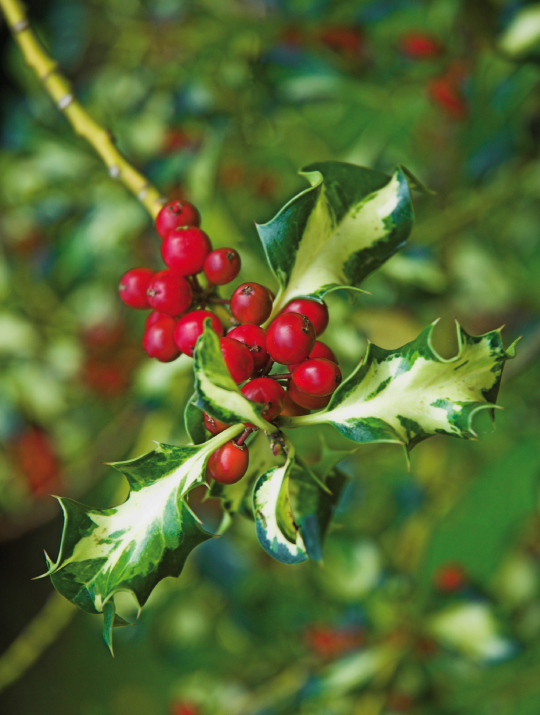 Winter often gets a bad rap because it’s a dormant season. While winter may leave you indoors meditating about preparing your yard for spring, you may be forgetting that it’s also is an ideal time to enjoy your yard’s textural bark, bright berries and funky foliage—those things that give it the interest it needs during barren months. Since fall is a great time for planting, consider these options now to enhance your winter landscape.
Winter often gets a bad rap because it’s a dormant season. While winter may leave you indoors meditating about preparing your yard for spring, you may be forgetting that it’s also is an ideal time to enjoy your yard’s textural bark, bright berries and funky foliage—those things that give it the interest it needs during barren months. Since fall is a great time for planting, consider these options now to enhance your winter landscape.
Architectural Arbors
The naked silhouettes of trees can be appreciated as focal points within your yard. After foliage has fallen, unusual branching configurations and interesting bark textures create stunning architectural impact.
The American yellowwood’s smooth gray bark and curvy branches give its naked limbs a sleek, graceful look in winter. At full maturity, it grows to 50 feet, and is also beautiful in spring, budding snowy white pea-like flowers.
The Crape myrtle tree, popular throughout the South, grows upright or in a broad canopy shape, and ranges from 4 feet to 25 feet tall. This tree is stunning in all seasons, with its glossy, dark green foliage turning yellow, orange and red during the fall, and its crepe paper-looking flowers in bloom from mid-June to September. In winter, after the foliage falls, the Crape myrtle boasts ornamental exfoliating bark. The paper-like bark flakes away in an irregular pattern, exposing grays, tans and browns. This deciduous evergreen also comes in shrub varieties that can be planted in groupings, or a line to create a hedge or screen.
Other trees that have exfoliating bark include lacebark pine with its olive green, reddish-brown and gray peeling bark, or the paperbark maple with its cinnamon-brown bark that peels off in curly strips. The paperbark maple also develops crimson foliage late in autumn that lasts throughout winter.
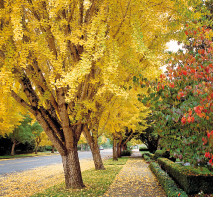 Other trees, such as the Ginkgo (also know as maidenhair), have bark that adds texture to a quiet winter yard. The hearty shade tree grows to a towering 80 feet and has light brown bark with deep ridges. Older Ginkgo trees develop a bark with a more cork-like texture.
Other trees, such as the Ginkgo (also know as maidenhair), have bark that adds texture to a quiet winter yard. The hearty shade tree grows to a towering 80 feet and has light brown bark with deep ridges. Older Ginkgo trees develop a bark with a more cork-like texture.
Shape is another characteristic to create visual appeal in your yard. Cone-shaped conifers like the dan redwood can be planted in groupings along paths and driveways to create an alley. Small, flat-topped trees like the Flowering dogwood have horizontal branching and lower tiers of branches that droop. This tree also has great trunk texture, with blocky-looking bark that resembles alligator hide.
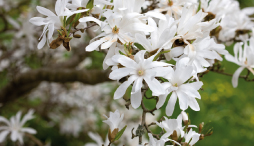 Ornamental Blossoms and Berries
Ornamental Blossoms and Berries
If you are anxious for spring’s bright blooms, then try out these early bloomers whose petals will unfold well before the equinox.
The fall-flowering cherry is a 25- to 30-foot tree with light pink blossoms that open in late fall and again in late winter. Another pink-petaled beauty is the Japanese flowering apricot with its almond-scented blooms that draw bees, butterflies and birds. The 15-foot tree also has blooms in red and white hues and features ornamental yellow fruit.
For a unique bloom, the Star magnolia tree creates visual appeal with its white, star-like flowers that start out as fuzzy buds. The flowers have long, layered white petals, and a reddish-green fruit that opens in autumn. The tree can grow up to 20 feet tall, and also comes in
shrub varieties.
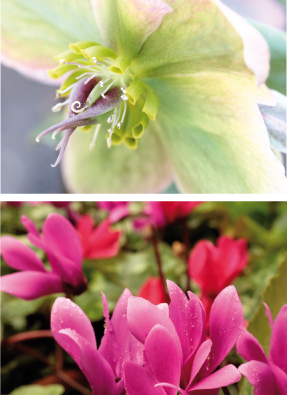 Flowering shrubs are smaller showcase pieces. Camellias have evergreen foliage and blooms that range from crisp white to deep pink. They flower in early winter through early spring. Other blooming shrubs include pink and purple heather, yellow winter jasmine and the fragrant, creamy-white winter honeysuckle.
Flowering shrubs are smaller showcase pieces. Camellias have evergreen foliage and blooms that range from crisp white to deep pink. They flower in early winter through early spring. Other blooming shrubs include pink and purple heather, yellow winter jasmine and the fragrant, creamy-white winter honeysuckle.
Witch hazel shrubs also have beautiful blooms and are very fragrant. Their crinkled petals curl up on cold nights and are coaxed open during warmer days. The bright yellow ‘Arnold Promise’ variety opens in late winter, and the pale yellow ‘Primavera’ opens two to three weeks earlier. Planting witch hazel where it gets ample sunlight will highlight the yellow hues in this plant.
Berries add vibrant color and a yuletide feel to your yard. The winterberry is an upright oval-shaped shrub that can reach 10 feet tall. Its showy bright red fruit lasts from early autumn through February.
Nandina is a hearty shrub that is easy to grow in shade or sun. The 5- to 8-foot-tall nandina domestica, called by its admirers “heavenly bamboo” for its bamboo-like foliage, blooms brilliant flowers that produce red berries in the winter. The shrub is just as beautiful in fall, when foliage turns bronze, red, orange and even pink.
Hollies have dainty berries and hearty foliage, and there are many varieties. The American holly, which ranges from 15 to 30 feet, is heartier than other varieties. Blue holly is a shrub-sized hybrid with glossy, rich green leaves, with purple stems and berries. Foster’s holly has adapted to warmer climates, like here in Virginia, and is a 20- to 30-foot-tall tree with glossy, medium-green leaves and deep red berries.
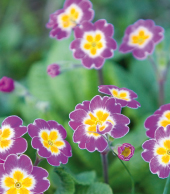 Late-Winter Blooming Perennials
Late-Winter Blooming Perennials
Our moderate climate also allows for flowers such as primroses, cyclamens and other cool-weather perennials. Two of the earliest-blooming primroses, known to peek their heads up through late winter snowfall, are the English primrose with pale yellow blooms and the cowslip primrose with fragrant yellow flowers. Primrose seeds should be sown in trays in early spring and then transferred to the outdoors. Cyclamens bloom between December and May, with flowers ranging from maroon and red to white with silvery marbled foliage. Bulbs can be planted as late as September.
For bold colors, perennials like the Amur adonis’ yellow blooms and fernlike leaves make a statement, or the Corsican hellebore with its large heads of apple green blossoms. Other funky colors like chartreuse will wake up your yard in winter. Bearsfoot hellebore’s chartreuse bell-like flowers create contrast next to the apple green Corsican hellebore.
More traditional flowers like the Christmas rose are common in winter gardens with their big white flowers that bloom February through May. The Lenten rose, a shade perennial with rich evergreen foliage, is another common cool-weather perennial with pink, burgundy, red, purple and white blooms.
Blooms and berries will give your yard the rich colors it needs against the winter’s muted backdrop, while the intricate, organic framework of branches and textures of trunks will add structural definition. Admired in this light, your yard can offer you solace and enjoyment all year long.






